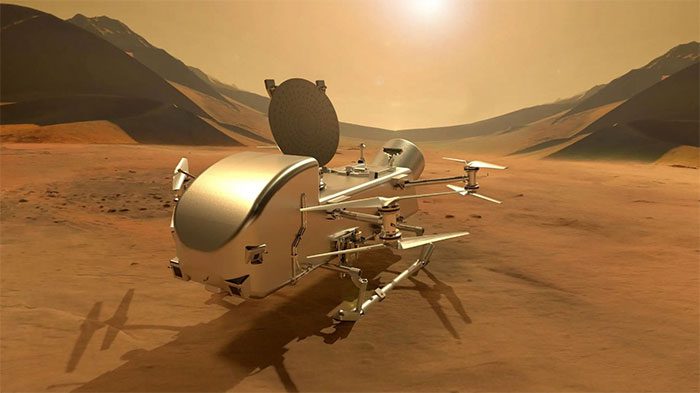Recent research by scientists aims to clarify the mysterious winds on Titan—the largest moon of Saturn, which has puzzled astronomers for decades.
Researchers state that the answers could help explain why Titan is the only moon in the Solar System that retains a planet-like atmosphere.
Astronomers have long known that seasons on Titan—each lasting nearly 7.5 Earth years—affect the moon’s winds. However, they have been unable to determine the speed of these winds. Two related studies, conducted nearly 30 years apart, have led to conflicting findings.

Surface simulation of Titan.
Now, astronomers are revisiting this decades-old mystery using upgraded telescopes. The contradictory findings from previous studies may result from inaccurate assumptions due to limitations in data or tools, or it may simply be, as Eliot Young, the lead scientist at the Southwest Research Institute in Texas, describes, “something fundamental that we do not fully understand.”
Titan has a thick, hazy atmosphere that extends up to 370 miles (600 km) high, composed of 95% nitrogen and a small amount of organic molecules. Winds on Saturn’s largest moon circle it continuously in a day, constantly transporting warm air from lower latitudes to the moon’s poles, a mechanism NASA refers to as a high-speed conveyor belt.
In 1989, astronomers discovered that Titan’s winds are slowest near its equator and fastest at mid-latitudes in both the northern and southern hemispheres. This was revealed through an accidental observation of a star aligned behind Titan, allowing astronomers to study how the star’s faint light passes through the moon’s atmosphere, helping them interpret wind speeds.
In 2016, another group used ground-based telescopes to study how light emitted from molecules in the atmosphere changes with varying wind speeds and directions. Findings from this method indicated the opposite: winds blow fastest near Titan’s equator and slow down at lower latitudes of the moon.
Due to the three-decade gap between the two observational groups, astronomers speculate that changing seasons on Titan could have caused significant wind shifts between the two studies. Additionally, the 1989 group studied winds in the middle layers of Titan’s atmosphere, while the more recent study focused on winds in the upper layers. Therefore, astronomers suggest that this could also explain the differing wind speeds.
Juan Lora, an assistant professor of Earth and planetary sciences at Yale University, analyzed: “Like on Earth, winds on Titan vary at different altitudes and also change seasonally. Both of these factors likely explain why the observations do not completely match.”
To understand the root of these differences, a team of scientists collected new data on Titan’s winds using both methods simultaneously. Last year, the team utilized eight telescopes in the United States and South America to observe the alignments of Earth, Titan, and distant glowing stars.
In September 2022, four telescopes in Hawaii observed the star 2MASS 21312124-1602427, which was behind Titan. Also, in November of last year, another star named 2MASS 21292356-1611056 was observed behind Titan. Data from this event was collected by four other telescopes in Chile.
The research team is still comparing data from both observations and hopes to have results by the end of this year. Martin Cordiner, a planetary scientist at NASA’s Goddard Space Flight Center in Maryland, stated: “So far, observations from the ALMA observatory have shown evidence of high-speed winds parallel to Titan’s equator.”
Experts involved in the latest research noted that they were able to collect valuable data on Titan’s winds in the northern hemisphere before the equinox in 2025, when both hemispheres of Saturn’s largest moon receive sunlight equally for a brief period before the northern hemisphere tilts more directly toward the sun. According to Nature magazine, during this time, Titan’s winds will reverse direction and begin blowing from north to south—a change that has stirred up powerful dust storms in the past.
With the success of the Mars helicopter Ingenuity, NASA plans to deploy another “explorer” robot to Titan. Set to launch in 2034, NASA’s Dragonfly mission will be a robotic rotorcraft tasked with exploring Saturn’s moon Titan, a satellite particularly intriguing to scientists because it is believed to have the potential to support life.
The mission’s primary goal is to assess the moon’s habitability by studying both its atmosphere and surface while approaching areas that are difficult to research from orbit due to the thickness of the atmosphere.
To conduct this research, the Dragonfly helicopter will carry a device called “Dragonfly Mass Spectrometer” (DraMS).
Similar to the system aboard the Mars rover, the Dragonfly device is used to analyze samples. These samples will be collected by a drill named “Complex Organic Compositions Acquisition Drill” (DrACO).
When DrACO collects a sample, the mass spectrometer will bombard it with energy to ionize its molecules. The device can then sort these ions by their mass and charge and measure them to determine the composition of each sample.
This means that DraMS will be able to analyze the surface composition of Titan. Researchers are also particularly interested in whether the surface of this satellite possesses chemical components that support the formation of life.


















































